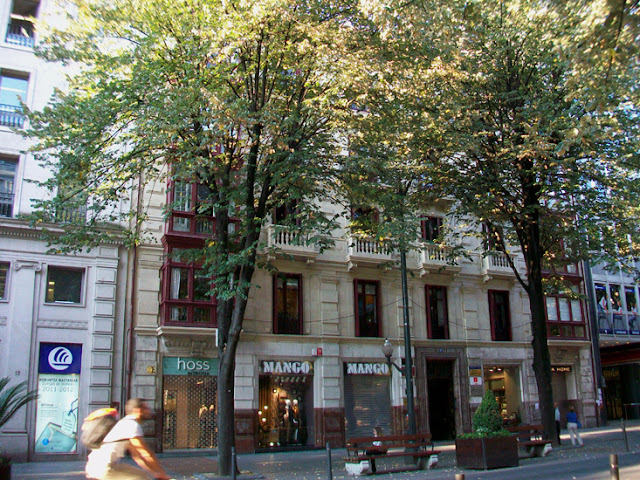The Round Plaza
This is one of the most important plazas in the Ensanche of Bilbao (the XIXth Century Expansion Area), because it connects it to the Old Quarter. Today it's not properly a plaza, but a roundabout which redirects the traffic of people and vehicles. As the Moyua Plaza is called The Oval Plaza (Plaza elíptica), this one has been given the name "Round Plaza" (Plaza Biribila in basque).
During the last decades of the Ninetenth Century, the old city found its way to a new Bilbao, the Bilbao of the "Ensanche", through the bridge called Puente del Arenal and along Navarra Street. Plaza Circular is the link between Navarre Street and the Gran Via. And as the beggining of the Gran Via, this is where the banks and financial enterprises began their leap from the Old Quarter.
During the last decades of the Ninetenth Century, the old city found its way to a new Bilbao, the Bilbao of the "Ensanche", through the bridge called Puente del Arenal and along Navarra Street. Plaza Circular is the link between Navarre Street and the Gran Via. And as the beggining of the Gran Via, this is where the banks and financial enterprises began their leap from the Old Quarter.
Aproaching the Plaza Circular from the Gran Via
On the left, the building of the BBK, the Bilbao Biscay Savings Bank. This building has been sold to the city Government on october 2011. On the right, the Abando railway station, from were suburban and long distance trains depart.
The statue of Don Diego López de Haro, Lord of Biscay, holding the foundation chart of the city is the work of a succesfull XIXth Century artist from Barcelona, Mariano Benlliure, who made lots of sculptures to order all around Spain.
On the other side of the Plaza, there is an old building between two modern banks.
There you can find the traditional Café La Granja
Buenos Aires Street will guide you to the City Council
Navarre Street (Calle de Navarra) goes directly to the Arenal Bridge and the Old Quarter.
The Biscay Bank had built the first skyscraper of the city in 1969 for its head office. In 1988, the Biscay Bank (Banco de Vizcaya) and the Bilbao Bank merged. From then on, this was the head office of the Bilbao Biscay Bank. Further on, BBV merged with another bank, Argentaria. So now these are the headquarters of BBVA (Bilbao Biscay Argentaria Bank)..
Eulogy of Iron is a sculpture made by the basque artist Eduardo Chillida.
It was placed here on June 1997.












































































